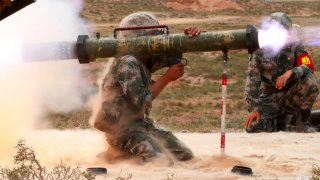by Peter Suciu
The situation at the Line of Actual Control (LAC)—the de facto border between India and China along the Himalayas—is getting more tenuous. The two countries share what is one of the world’s longest unsettled borders and it is divided into western, middle and eastern sectors. The loose demarcation line was formed after the 1962 Sino-Indian War and looks no closer to be resolved any time soon.
The most serious of the ongoing standoffs between the two sides have taken place along points in the western sector, where clashes between troops on both sides of the LAC have increased with greater regularity and notable tenacity. This week at least twenty Indian soldiers were killed while some forty-three Chinese soldiers were also injured or killed in the most recent clash.
While leaders on both sides have sought to de-escalate the situation with words, their actions actually speak volumes.
In the past month India conducted jet fighter sorties over Ladakh near the demarcation line, and this week China’s People’s Liberation Army (PLA) responded by conducting high-altitude drills in the remote mountain region near Tibet.
“An infantry battalion at the PLA Tibet Military Region recently organized infantry-tank cooperation drills at an undisclosed location at an elevation of more than 4,700 meters, putting the troops’ teamwork and rapid-response capabilities to a comprehensive test,” the PLA Tibet Military Region said in a statement reported by the Global Times.
The exercises also involved Beijing’s new Type 15 tank, which made its public debut at the National Day military parade last October. The lightweight tank, which is highly mobile on the plateaus, was first deployed near the LAC in January.
The Type 15 lightweight tank has a thinner armor and smaller 105-millimeter main gun—both of which could make it more suitable for operations in the mountainous conditions near the LAC. The Norinco-produced tank at thirty-three-tons is about half the weight of a typical main battle tank, which is necessary given the thinner air and rugged terrain. Heavier armored vehicles typically struggle due to the lack of oxygen to support the engine.
However, the Type 15’s one-thousand horsepower engine still is able to provide enough “pep” to handle the terrain and get in and out of fights quickly, while its 105-millimeter gun can fire armor-piercing shells as well as guided missiles.
In another exercise, Chinese Type 99 main battle tanks attached to a brigade under the PLA 76th Group Army participated in a separate exercise in the mountainous plateau earlier this month. While much heavier than the Type 15, the Type 99—which seems influenced by the Soviet T-72 as well as western-style tanks such as Germany’s Leopard 2—has stronger firepower and greater armor protection yet can still handle the high-altitude conditions.
While efforts continue to de-escalate the situation, including multi-level meetings on the ground, it also seems that both sides continue to prepare for war while hoping for peace.
Peter Suciu is a Michigan-based writer who has contributed to more than four dozen magazines, newspapers and websites. He is the author of several books on military headgear including A Gallery of Military Headdress, which is available on Amazon.com.

No comments:
Post a Comment